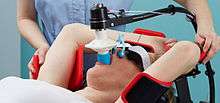Deep inspiration breath-hold
Deep inspiration breath-hold (DIBH) is a method of delivering radiotherapy while limiting radiation exposure to the heart and lungs.[1] It is used primarily for treating left-sided breast cancer.

The technique involves a patient holding their breath during treatment. In DIBH techniques, treatment is only delivered at certain points in the breathing cycle, where the patient holds their breath. Since the relative positions of organs in the chest naturally changes during breathing, this allows treatment to be delivered to the target (tumour) while other organs are in the optimal position to receive least dose.[2]
Treatment Methods
In the DIBH technique, the patient is initially maintained at quiet tidal breathing (i.e. normal, relaxed breathing),[3] followed by a deep inspiration, a deep expiration, a second deep inspiration, and breath-hold. At this point the patient is at approximately 100% vital capacity, and simulation, verification, and treatment take place during this phase of breath-holding.[4] Patients will have their lung capacity and natural breathing cycle measured so that a comfortable breath-hold capacity can be set. During DIBH, the patient may wear a pair of video goggles which displays their breathing cycle and shows them when they need to inhale and hold their breath.[5] Patients who cannot maintain DIBH can still benefit from lung tracking techniques, for example 4DCT.[6]
There are two basic methods of performing DIBH: free-breathing breath-hold, and spirometry-monitored deep inspiration breath hold.[7]
Free-breathing breath-hold
Free-breathing breath-hold, also known as real-time position management (RPM) DIBH utilises an infra-red camera and markers placed on the patient to track movement of their chest, and their breathing.[8]
Spirometry-monitored breath-hold
Spirometry based designs are known as active breathing coordinator (ABC) DIBH systems. ABC utilises a mouth piece for the patient which can be used to control the flow of air to provide more reproducible results.[9]
Effectiveness
The DIBH technique provides an advantage to conventional free-breathing treatment by decreasing lung density, reducing normal safety margins, and enabling more accurate treatment. These improvements contribute to the effective exclusion of normal lung tissue from the high-dose region and permit the use of higher treatment doses without increased risks of toxicity.[4]
Treatment of patients with the DIBH technique is feasible in a clinical setting. With this technique, consistent lung inflation levels are achieved in patients, as judged by both spirometry and verification films. Breathing-induced tumor motion is significantly reduced using DIBH compared to free breathing, enabling better target coverage.[10]
Future research
There is currently no clear selection criteria to predict which patients will benefit most from the DIBH technique, other than left breast laterality. There is evidence to suggest parasagittal cardiac contact distance is a promising metric for selection and should be assessed in all future DIBH planning studies.[11]
References
- Hanley, J; Debois, M. M.; Mah, D; Mageras, G. S.; Raben, A; Rosenzweig, K; Mychalczak, B; Schwartz, L. H.; Gloeggler, P. J.; Lutz, W; Ling, C. C.; Leibel, S. A.; Fuks, Z; Kutcher, G. J. (1999). "Deep inspiration breath-hold technique for lung tumors: The potential value of target immobilization and reduced lung density in dose escalation". International Journal of Radiation Oncology, Biology, Physics. 45 (3): 603–11. doi:10.1016/S0360-3016(99)00154-6. PMID 10524412.
- "Deep Inspiration Breath Hold Technique (DIBH)". Action Radiotherapy. Retrieved 4 November 2017.
- Palmer, John; Allen, Julian; Mayer, Oscar (May 2004). "Tidal Breathing Analysis". NeoReviews. 5 (5): e186–e193. doi:10.1542/neo.5-5-e186.
- Rosenzweig, K. E.; Hanley, J; Mah, D; Mageras, G; Hunt, M; Toner, S; Burman, C; Ling, C. C.; Mychalczak, B; Fuks, Z; Leibel, S. A. (2000). "The deep inspiration breath-hold technique in the treatment of inoperable non-small-cell lung cancer". International Journal of Radiation Oncology, Biology, Physics. 48 (1): 81–7. doi:10.1016/s0360-3016(00)00583-6. PMID 10924975.
- "Deep Inspiration Breath-Hold". Linford Wood Medical Centre. Retrieved 2016-01-14.
- Bourland, J. Daniel (2012). Image-Guided Radiation Therapy. CRC Press. p. 196. ISBN 9781439802731.
- Latty, Drew; Stuart, Kirsty E.; Wang, Wei; Ahern, Verity (March 2015). "Review of deep inspiration breath-hold techniques for the treatment of breast cancer". Journal of Medical Radiation Sciences. 62 (1): 74–81. doi:10.1002/jmrs.96. PMC 4364809. PMID 26229670.
- Nagata, Yasushi (2015). Stereotactic Body Radiation Therapy: Principles and Practices. Springer. p. 52. ISBN 9784431548836.
- Bellon, Jennifer R.; Wong, Julia S.; MacDonald, Shannon M.; Ho, Alice Y. (2016). Radiation Therapy Techniques and Treatment Planning for Breast Cancer. Springer. p. 80. ISBN 9783319403922.
- Mah, D; Hanley, J; Rosenzweig, K. E.; Yorke, E; Braban, L; Ling, C. C.; Leibel, S. A.; Mageras, G (2000). "Technical aspects of the deep inspiration breath-hold technique in the treatment of thoracic cancer". International Journal of Radiation Oncology, Biology, Physics. 48 (4): 1175–85. doi:10.1016/s0360-3016(00)00747-1. PMID 11072177.
- Latty, Drew; Stuart, Kirsty E; Wang, Wei; Ahern, Verity (2015-03-01). "Review of deep inspiration breath-hold techniques for the treatment of breast cancer". Journal of Medical Radiation Sciences. 62 (1): 74–81. doi:10.1002/jmrs.96. ISSN 2051-3895. PMC 4364809. PMID 26229670.